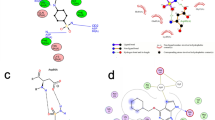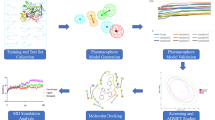Abstract
Interaction of intranuclear β-amyloid with DNA is considered to be a plausible mechanism of Alzheimer’s disease pathogenesis. The interaction of single- and double-stranded DNA with synthetic peptides was analyzed using surface plasmon resonance. The peptides represent the metal-binding domain of β-amyloid (amino acids 1–16) and its variants with chemical modifications and point substitutions of amino acid residues which are associated with enhanced neurotoxicity of β-amyloid in cell tests. It has been shown that the presence of zinc ions is necessary for the interaction of the peptides with DNA in solution. H6R substitution has remarkably reduced the ability of domain 1–16 to bind DNA. This is in accordance with the supposition that the coordination of a zinc ion by amino acid residues His6, Glu11, His13, and His14 of the β-amyloid metal-binding domain results in the occurrence of an anion-binding site responsible for the interaction of the domain with DNA. Zinc-induced dimerization and oligomerization of domain 1–16 associated with phosphorylation of Ser8 and the presence of unblocked amino- and carboxy-terminal groups have resulted in a decrease of peptide concentrations required for detection of the peptide-DNA interaction. The presence of multiple anion-binding sites on the dimers and oligomers is responsible for the enhancement of the peptide-DNA interaction. A substitution of the negatively charged residue Asp7 for the neutral residue Asn in close proximity to the anion-binding site of the domain 1–16 of Aβ facilitates the electrostatic interaction between this site and phosphates of a polynucleotide chain, which enhances zinc-induced binding to DNA.
Similar content being viewed by others
References
Goedert M., Spillantini M.G. 2006. A century of Alzheimer’s disease. Science. 314, 777–781.
D’Andrea M.R., Nagele R.G., Wang H.Y., Lee D.H. 2002. Consistent immunohistochemical detection of intracellular beta-amyloid42 in pyramidal neurons of Alzheimer’s disease entorhinal cortex. Neurosci. Lett. 333, 163–166.
Grundke-Iqbal I., Iqbal K., George L., Tung Y.C., Kim K.S., Wisniewski H.M. 1989. Amyloid protein and neurofibrillary tangles coexist in the same neuron in Alzheimer disease. Proc. Natl. Acad. Sci. U. S. A. 86, 2853–2857.
Takahashi R.H., Milner T.A., Li F., Nam E.E., Edgar M.A., Yamaguchi H., Beal M.F., Xu H., Greengard P., Gouras G.K. 2002. Intraneuronal Alzheimer Abeta42 accumulates in multivesicular bodies and is associated with synaptic pathology. Am. J. Pathol. 161, 1869–1879.
Gouras G.K., Tsai J., Naslund J., Vincent B., Edgar M., Checler F., Greenfield J.P., Haroutunian V., Buxbaum J.D., Xu H., Greengard P., Relkin N.R. 2000. Intraneuronal Abeta42 accumulation in human brain. Am. J. Pathol. 156, 15–20.
Wirths O., Bayer TA. 2012. Intraneuronal Aβ accumulation and neurodegeneration: Lessons from transgenic models. Life Sci. 91, 1148–1152.
Wirths O., Multhaup G., Bayer T.A. 2004. A modified beta-amyloid hypothesis: Intraneuronal accumulation of the beta-amyloid peptide-the first step of a fatal cascade. J. Neurochem. 91, 513–520.
Li M., Chen L., Lee D.H., Yu L.C., Zhang Y. 2007. The role of intracellular amyloid β in Alzheimer’s disease. Prog. Neurobiol. 83, 131–139.
Gouras G.K., Almeida C.G., Takahashi R.H. 2005. Intraneuronal Abeta accumulation and origin of plaques in Alzheimer’s disease. Neurobiol. Aging. 26, 1235–1244.
Penke B., Toth A.M., Foldi I., Szucs M., Janaky T. 2012. Intraneuronal β-amyloid and its interactions with proteins and subcellular organelles. Electrophoresis. 33, 3608–3616.
Johnstone E.M., Babbey L.E., Stephenson D., Paul D.C., Santerre R.F., Clemens J.A., Williams D.C., Little S.P. 1996. Nuclear and cytoplasmic localization of the betaamyloid peptide (1–43) in transfected 293 cells. Biochem. Biophys. Res. Commun. 27, 710–718.
Buckig A., Tikkanen R., Herzog V., Schmitz A. 2002. Cytosolic and nuclear aggregation of the amyloid betapeptide following its expression in the endoplasmic reticulum. Histochem. Cell. Biol. 118, 353–360.
Ohyagi Y., Asahara H., Chui D.H., Tsuruta Y., Sakae N., Miyoshi K., Yamada T., Kikuchi H., Taniwaki T., Murai H., Ikezoe K., Furuya H., Kawarabayashi T., Shoji M., Checler F., Iwaki T., Makifuchi T., Takeda K., Kira J., Tabira T. 2005. Intracellular Abeta42 activates p53 promoter: A pathway to neurodegeneration in Alzheimer’s disease. FASEB J. 19, 255–257.
Bailey J.A., Maloney B., Ge Y.W., Lahiri D.K. 2011. Functional activity of the novel Alzheimer’s amyloid β-peptide interacting domain (AβID) in the APP and BACE1 promoter sequences and implications in activating apoptotic genes and in amyloidogenesis. Gene. 488, 13–22.
Cardinale A., Racaniello M., Saladini S., De Chiara G., Mollinari C., de Stefano M.C., Pocchiari M., Garaci E., Merlo D. 2012. Sublethal doses of β-amyloid peptide abrogate DNA-dependent protein kinase activity. J. Biol. Chem. 287, 2618–2631.
Jimenez J.S. 2010. Protein-DNA interaction at the origin of neurological diseases: A hypothesis. J. Alzheimer’s Dis. 22, 375–391.
Yu H., Ren J., Qu X. 2007. Time-dependent DNA condensation induced by amyloid beta-peptide. Biophys. J. 92, 185–191.
Hegde M.L., Anitha S., Latha K.S., Mustak M.S., Stein R., Ravid R., Rao K.S. 2004. First evidence for helical transitions in supercoiled DNA by amyloid beta peptide (1–42) and aluminum: A new insight in understanding Alzheimer’s disease. J. Mol. Neurosci. 22, 19–31.
Maloney B., Lahiri D.K. 2011. The Alzheimer’s amyloid β-peptide (Aβ) binds a specific DNA Aβ-interacting domain (AβID) in the APP, BACE1, and APOE promoters in a sequence-specific manner: Characterizing a new regulatory motif. Gene. 488, 1–12.
Geng J., Zhao C., Ren J., Qu X. 2010. Alzheimer’s disease amyloid beta converting left-handed Z-DNA back to right-handed B-form. Chem. Commun. 46, 7187–7189.
Camero S., Ayuso J.M., Barrantes A., Benítez M.J., Jimenez J.S. 2013. Specific binding of DNA to aggregated forms of Alzheimer’s disease amyloid peptides. Int. J. Biol. Macromol. 55, 201–206.
Lahiri D.K., Maloney B. 2010. Beyond the signaling effect role of amyloid-β42 on the processing of APP, and its clinical implications. Exp. Neurol. 225, 51–54.
Faller P. 2009. Copper and zinc binding to amyloidbeta: Coordination, dynamics, aggregation, reactivity and metal-ion transfer. ChemBioChem. 10, 2837–2845.
Khmeleva S.A., Mezentsev Y.V., Kozin S.A., Tsvetkov P.O., Ivanov A.S., Bodoev N.V., Makarov A.A., Radko S.P. 2013. Zinc-induced interaction of the metal-binding domain of amyloid-β peptide with DNA. J. Alzheimer’s Dis. 36, 633–636.
Ono K., Condron M.M., Teplow D.B. 2010. Effects of the English (H6R) and Tottori (D7N) familial Alzheimer disease mutations on amyloid beta-protein assembly and toxicity. J. Biol. Chem. 30, 23186–23197.
Kumar S., Rezaei-Ghaleh N., Terwel D., Thal D.R., Richard M., Hoch M., Mc Donald J.M., Wüllner U., Glebov K., Heneka M.T., Walsh D.M., Zweckstetter M., Walter J. 2011. Extracellular phosphorylation of the amyloid β-peptide promotes formation of toxic aggregates during the pathogenesis of Alzheimer’s disease. EMBO J. 30, 2255–2265.
Zirah S., Kozin S.A., Mazur A.K., Blond A., Cheminant M., Ségalas-Milazzo I., Debey P., Rebuffat S. 2006. Structural changes of region 1–16 of the Alzheimer disease amyloid beta-peptide upon zinc binding and in vitro aging. J. Biol. Chem. 27, 2151–2161.
Tsvetkov P.O., Kulikova A.A., Golovin A.V., Tkachev Y.V., Archakov A.I., Kozin S.A., Makarov A.A. 2010. Minimal Zn2+ binding site of amyloid-β. Biophys. J. 99, 84–86.
McNutt M., Mullins L.S., Raushel F.M., Pace C.N. 1990. Contribution of histidine residues to the conformational stability of ribonuclease T1 and mutant Glu-58-Ala. Biochemistry. 29, 7572–7576.
Kozin S.A., Kulikova A.A., Istrate A.N., Tsvetkov P.O., Zhokhov S.S., Mesentsev Y.V., Ivanov A.S., Polshakov V.I., Makarov A.A. 2015. The English (H6R) familial Alzheimer’s disease mutation facilitates zinc-induced dimerization of the amyloid-β metal-binding domain. Metallomics. 70, 422–425.
Kozin S.A., Zirah S., Rebuffat S., Hoa G.H., Debey P. 2001. Zinc binding to Alzheimer’s Abeta(1–16) peptide results in stable soluble complex. Biochem. Biophys. Res. Commun. 285, 959–964.
Ali F.E., Separovic F., Barrow C.J., Yao S., Barnham K.J. 2006. Copper and zinc mediated oligomerisation of Aβ peptides. Int. J. Pept. Res. Ther. 12, 153–164.
Kulikova A.A., Tsvetkov P.O., Indeykina M.I., Popov I.A., Zhokhov S.S., Golovin A.V., Polshakov V.I., Kozin S.A., Nudler E., Makarov A.A. 2014. Phosphorylation of Ser8 promotes zinc-induced dimerization of the amyloid-β metal-binding domain. Mol. Biosyst. 10, 2590–2596.
Colvin R.A., Bush A.I., Volitakis I., Fontaine C.P., Thomas D., Kikuchi K., Holmes W.R. 2008. Insights into Zn2+ homeostasis in neurons from experimental and modeling studies. Am. J. Physiol. Cell Physiol. 294, 726–742.
Alies B., Hureau C., Faller P. 2013. The role of metal ions in amyloid formation: General principles from model peptides. Metallomics. 5, 183–192.
Tougu V., Karafin A., Palumaa P. 2008. Binding of zinc(II) and copper(II) to the full-length Alzheimer’s amyloid-β peptide. J. Neurochem. 104, 1249–1259.
Tsvetkov F.O., Makarov A.A., Archakov A.I., Kozin S.A. 2009. Effect of isomerization of aspartate-7 on the binding of copper(II) ion by the β-amyloid peptide. Biophysics (Moscow). 54 (2), 131–134..
Jiang D., Zhang L., Grant G.P., Dudzik C.G., Chen S., Patel S., Hao Y., Millhauser G.L., Zhou F. 2013. Elevated copper binding strength of amyloid-β aggregates enables their copper sequestration from albumin: A pathway to accumulation of copper in senile plaques. Biochemistry. 52, 547–556.
Author information
Authors and Affiliations
Corresponding author
Additional information
Original Russian Text © S.A. Khmeleva, Y.V. Mezentsev, S.A. Kozin, V.A. Mitkevich, A.E. Medvedev, A.S. Ivanov, N.V. Bodoev, A.A. Makarov, S.P. Radko, 2015, published in Molekulyarnaya Biologiya, 2015, Vol. 49, No. 3, pp. 507–514.
Rights and permissions
About this article
Cite this article
Khmeleva, S.A., Mezentsev, Y.V., Kozin, S.A. et al. Effect of mutations and modifications of amino acid residues on zinc-induced interaction of the metal-binding domain of β-amyloid with DNA. Mol Biol 49, 450–456 (2015). https://doi.org/10.1134/S0026893315020053
Received:
Accepted:
Published:
Issue Date:
DOI: https://doi.org/10.1134/S0026893315020053




